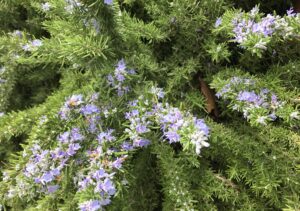Stabilize Slopes with Rosemary or Chamise?
Fall is a great time of year to stabilize slopes and reduce maintenance needs by reducing water usage. The Mediterranean native prostrate Rosemary covers many a Los Angeles slope. While drought tolerant when contrasted with traditional slope retainers like ivy, let’s see how Rosemary compares with its California native counterpart, Prostrate Chamise.
Prostrate Rosemary (Rosemarinus officinalis `Prostratus’)

Prostrate Rosemary’s prolific little blue blooms and intoxicating fresh fragrance give it great advantage in winning our hearts and minds. Its creeping form retains slopes well, and it has ample culinary uses. Its charms aside, common Rosemary is susceptible to disease in a garden setting. Neither is productive for slope retention in the long term.
Prostrate Chamise (Adenostoma fasciculatum `Nicholas’)
The Chamise variety “Nicolas” will creep to cover slopes and crawls to serve as a trailer over walls. Although Chamise may not be fragrant or useful in a culinary sense, you can expect to use a fraction of the water and effort used to maintain Rosemary. It is not only drought tolerant but incredibly disease resistant. Chamise will tough it out. Once it is established for a year or more, it may even be possible to go without supplemental water!
Looking for a supplement to a more upright form of Rosemary? The upright, Chaparral form of Chamise produces ample cotton-candy like blooms in in mid summer. (Check approved plant lists from your local fire department prior to using the upright form in high fire areas.)
Partner Chamise with colorful Penstemon heterophyllus and Epilobium canum for a compatible and vibrant arrangement of perennials.
Photo credits and additional resources: Please see our friends at CalScape, Las Pilitas and Theodore Payne Foundation Nurseries.